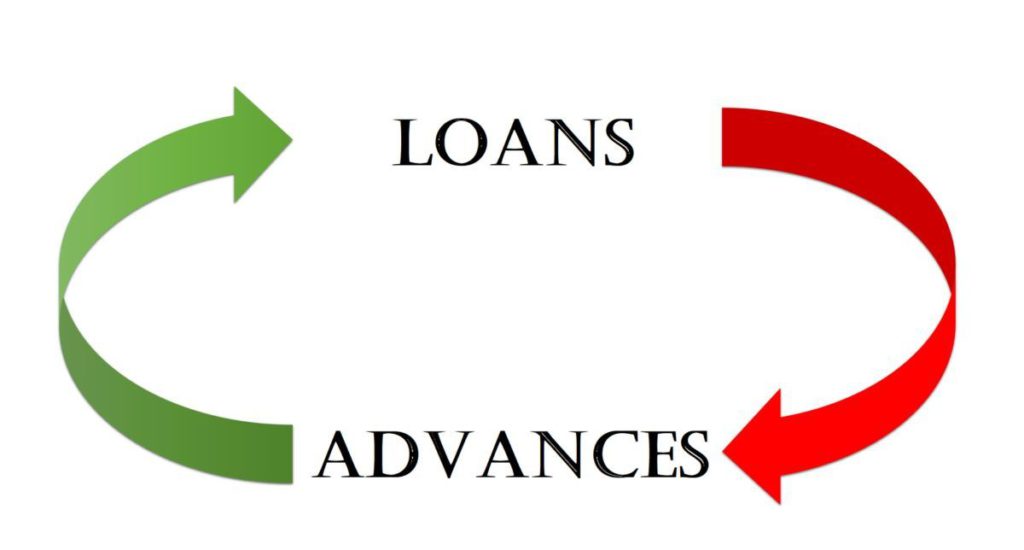Money is a necessary component of any business since it meets both short- and long-term funding requirements. Because the owner is unable to carry all of the funds with him, he must rely on loans and advances. Loans are short-term debts made by financial institutions, whilst Advances are money granted by banks to businesses to meet working capital needs that are due within one year.
The financial institutions and lenders bear the burden of providing loans and advances to consumers and businesses. When entrepreneurs are preparing to start a firm, they must examine the availability of loans and advances.
What is a Loan?
An amount that is in the form of debt given out by a financial organization to another firm or an individual in exchange for the future repayment of the same amount along with interest over a period.
The terms of a loan are mutually agreed by each party involved in the transaction before any exchange of funds take place.
What are Advances?
The source of financing provided by the banks to the companies, to meet their short-term requirements (less than one year). Contrasting to loans, advances are a credit facility. The terms of the advances are decided by the central bank (RBI in India), and the bank lending the amount.
Overview
A loan is a sum of money granted by financial institutions for a certain period of time. Banking institutions, on the other hand, make loans to businesses and Hindu undivided partnerships to cover their working capital requirements, often known as cash flows, for a one-year period.
Both loans include an interest component. Interest can be paid in inconvenient monthly instalments or all at once.
Demand loans, which must be paid back within three years of the date of sanction, and term loans, which must be paid back after three years, are two types of advances.
An Illustration of Loans and Advances
It has become increasingly difficult for the owner of a company to obtain funds from his confidential sources, leading the company to seek outside capital. The business owner requires cash for two reasons: operating capital (for day-to-day expenditures such as pay, labor, raw materials, etc.) and equipment purchases for his company.
Therefore, the firm owner contemplates obtaining funding from banks and other financial organizations. Assume the business owner enters his bank using the company’s checking account.
Types of Advances and Loans
- Short-term loan: When an advance is considered a short-term loan, the borrower can collect the full amount at one time.
- Overdraft: The bank allows the borrower to overdraw money up to a specified limit from his/her bank account.
- Bill Purchase: The borrower has to pledge bills to get the advance.
- Cash Credit: The bank allows the borrower to get advance money without keeping any credit balance.
Loans Types
- Secured loans: If a customer takes a secured loan, then he/she will have to submit collateral. The collateral or security can be seized by the lending institute if the borrower becomes a defaulter.
- Unsecured loans: Unsecured loans are sanctioned without the requirement of any collateral. Personal loans can be considered unsecured loans. Usually, the rate of interest charged for unsecured loans is also higher.
Key Distinctions
- Banks will examine the loan’s purpose and the business’s ability to repay it because it entails a significant amount of money and multiple legal processes.
- Businesses will be granted loans based on their repayment capabilities and track record.
- To prove the business’s purpose and repayment capabilities, the bank will require certain financial and non-financial documentation. During the promotion phase, however, less paperwork and legal formalities are necessary.
- There are secured and unsecured lending options available. However, if the loan amount is significant and the payback period is long, we must usually provide collateral.
- The loan is the best option for businesses with significant capital expenditure needs for corporate growth, such as machinery, plants, buildings, or any investment needing big money.
Loans vs. Advances Comparison Table
| The Basis Of Comparison | Loans | Advances |
| About | Funds lent by one entity to another for a purpose. (Usually for a Capital purpose) | Lent by a bank to firms to meet their short-term financial requirements |
| Nature | A loan is a debt by nature | Advances are a credit facility by nature |
| Time Duration | Loans are for a long-term | Advances are for a short-term (maximum one year) |
| Amount Involved | When a business establishment or an individual applies for a loan, the amount borrowed from a bank or a financial institution is usually big. | An advance is a form of credit. And so, the amount sanctioned is also smaller as compared to any type of loan amount. |
| Collateral Security | A loan may or may not be secured (Secured and Unsecured Loans) | Facilitated only against primary security or a guarantee |
| Legal Formality | Many legal procedures needed | Compared to Loans, low on legal formality |
| Example | Commercial Loan, Education Loan, Car Loan, Home Loan | Short-Term Loan, Cash Credit, Over Draft |
| Formality | The process of getting a loan is formal and structured. Even before applying for a loan, one needs to get through various administrative procedures. | Advances are approved only if the borrower satisfies the pre-defined requirements that can involve submitting collateral, enlisting primary security, and so on. |
| Payment Duration | The repayment tenure for loans can stretch for years. Home loans, auto loans, car loans, and even personal loans, can have long repayment tenure. | The repayment period for advances does not go beyond a year. It can start from 3 months to a year. |

